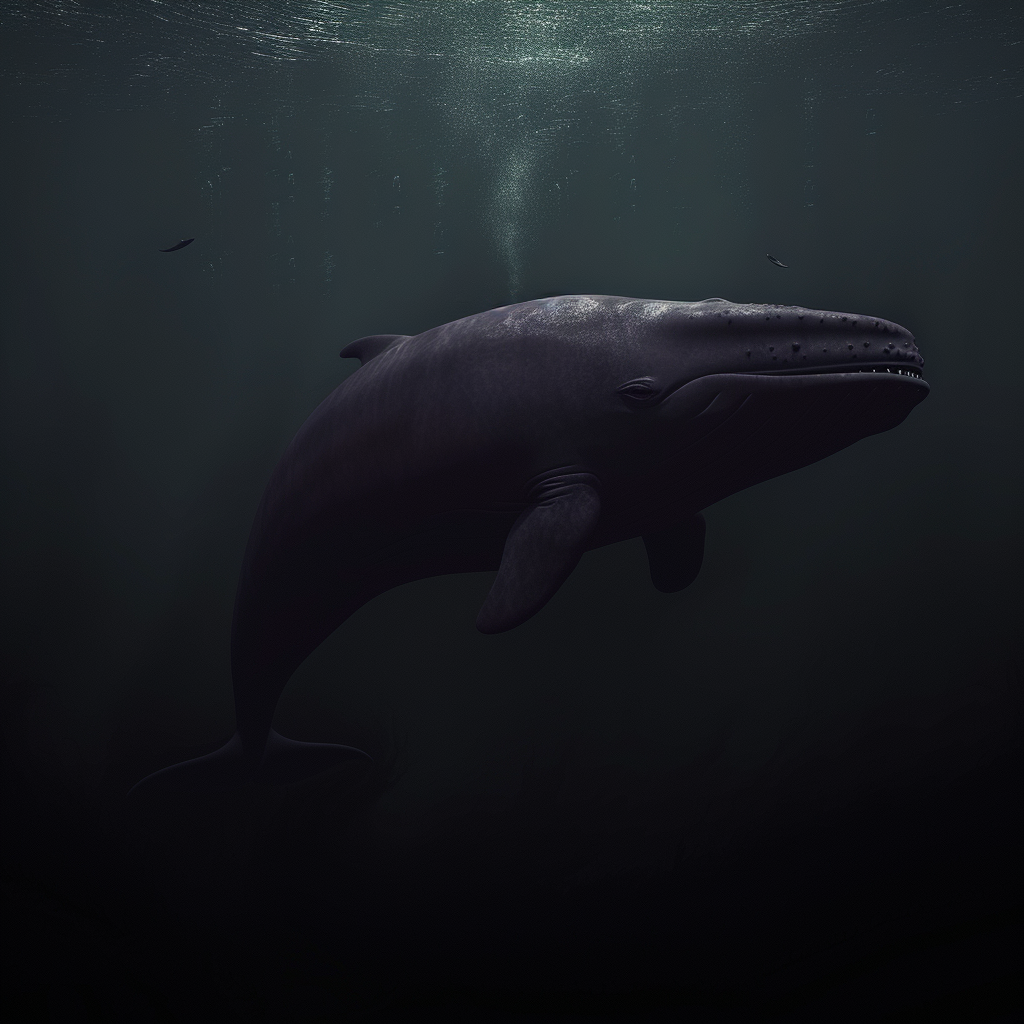Void Whale
Once the gentle giants of the Ephemeral Sea, these mutated remnants of the world that once was now present one of the most dangerous and sought after resources that remain available within those black waters. Moving through the dark waters, just below the ice floes, they move in a constant circuit from the northern ice caps through the Bay of Glass. They are one of the primary economic resources of the Hiversteadians, who have developed a number of methods to hunt them at great risk to themselves.
Basic Information
Anatomy
With an elongated body and a large, square shaped head, and a powerful tail ending in a pair of horizontally aligned fins, these creatures can reach sizes up to and sometimes exceeding twenty meters in length. They are mammalian and still contain a complex skeletal system and the need to breath oxygen, but retain the ability dive up to approximately 3 km, remaining submerged for up to an hour at a time.
Genetics and Reproduction
Void Whales are slow breeding animals, with a gestation period of about 15 months, birth of a single young and a long period of maternal care that follows. The female reached sexual maturity at approximately nine years of age, and they are capable or producing young every five to seven years.
Growth Rate & Stages
These creatures have natural life spans of seventy to eighty years, generally reaching sexual maturity within a decade. A female can continue breeding up to around forty years as well allowing the population to maintain a fairly constant growth.
Ecology and Habitats
Unlike their predecessors, the Void Whales seem to exist solely in the sub-arctic climates of the Bay of Glass, migrating under the ice shelves of the norther polar regions to parts unknown annually and returning later in the year to the Bay itself.
Dietary Needs and Habits
The whales diet is primarily filled with aquatic invertebrates and fish ranging from squid and sharks, to more common fish and skates. While they are able to subsist on various forms of zooplankton as well, most of those species are dwindling or now extinct. When food is scarce, they have been known to become more aggressive towards ships the encounter on the water, attacking them by ramming the crafts with their heads and then attempting to devour any creatures that fall into the water.
Behaviour
The whales move in pods of twenty to forty individual whales, using the groupings to form protective formations around the young and sexually mature females of the species. They have also been observed to use these grouping to teach they calves hunting and defensive techniques, these skills usually shown by the larger males of the pod. There have been instances where several pods have come together to form groups of up to a hundred whales, though these events are exceedingly rare.
The mutations that have affected the whales have boosted their intelligence significantly, causing behavioral shifts and a much less animal awareness. The whales are believed to have lengthy memories, remembering hunters that attempted to kill them and failed according to some accounts, seeking revenge and actively searching for the individuals that caused them harm.
Additional Information
Social Structure
The whales move in pods of both males and females that number from as small as twenty to as large as a hundred or more in the rare instances where several pods will combine as one. The bulls are polygamous, but do not keep any kind of long term attachment to mates, instead functioning as protectors and instructors for the young calves of the pod.
Uses, Products & Exploitation
Whale Oil
- Lubricant for watches, guns, fine instruments
- Mixed with sulfur for high impact machine lubricant
- Mining lamps, candles, etc.
- Rust-proofing compounds
- Leather tanning
- Pharmaceutical compounds
- Hormone extractions
- Soaps
Baleen
- Baskets
- Backscratchers
- Collar stiffeners
- Buggy whips
- Parasol ribs
- Switches
- Crinoline petticoats
- Corset stays
- Umbrella ribs
- Hat brims
- Fishing rods
- Shoe horns
- Cable backed bows
Ambergris
- Incense
- Aphrodisiac
- Flavor enhancement
- High end tobacco additive
- Pharmaceutical compounds
- Anti inflammatory
- Liver detox
Geographic Origin and Distribution
These whales inhabit the waters ranging from the northern polar caps to the Bay of Glass exclusively.
Average Intelligence
Void Whales are highly intelligent creatures, able to recognize and remember other creatures and even showing some base level problem solving skills. They are capable of working in a group to achieve goals and exhibit very organized behavior when doing so.
Perception and Sensory Capabilities
The Void Whale's senses are very reduced in capability, having boot a poor sense of taste and smell, as well as limited eyesight, lacking the ability to roll it's eyes in their sockets and instead having the ability to cause them to protrude outward slightly should the creature desire to examine something more closely. These creatures instead rely on their advanced abilities of echolocation to navigate and communicate over vast distances. The sounds generated by the whales reach up to 250 decibels, and they have been known to use their ability to generate sounds at this level to incapacitate or kill other creatures as a means of defense.
Scientific Name
Aquatic Mammal
Origin/Ancestry
Cachalot Whale
Lifespan
70 to 80 years
Average Weight
60 to 80 tonnes
Average Length
15 to 20 meters
Body Tint, Colouring and Marking
The external skin of these creatures ranges from ebony black to slight tints of violet around the eyes and mouth.
Geographic Distribution





Comments